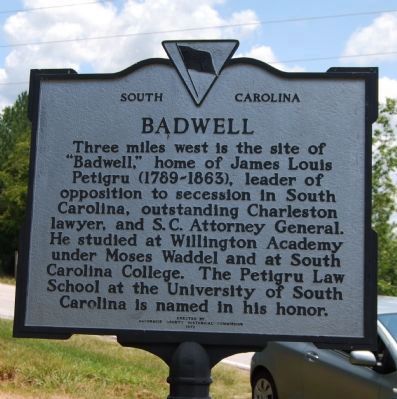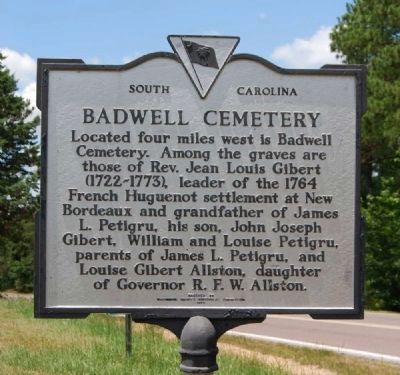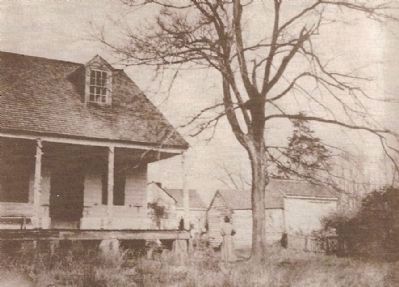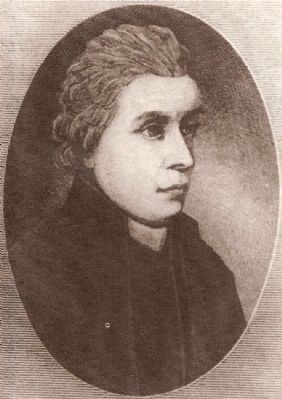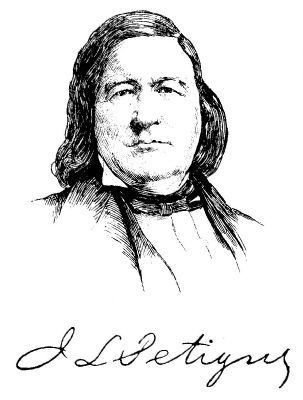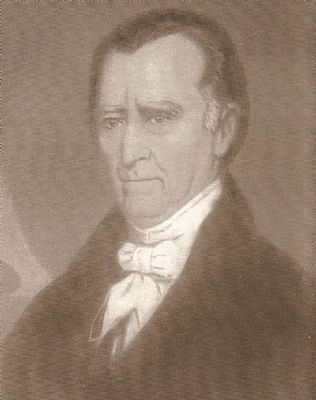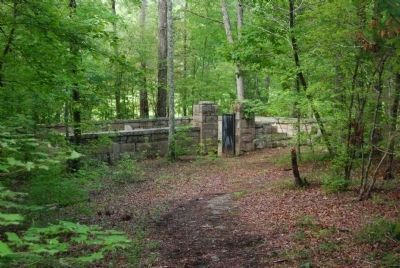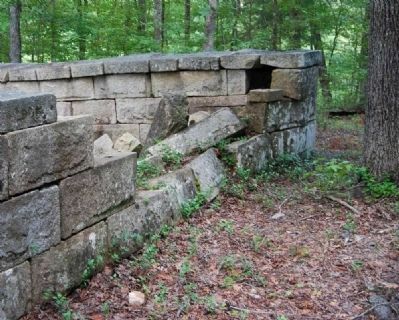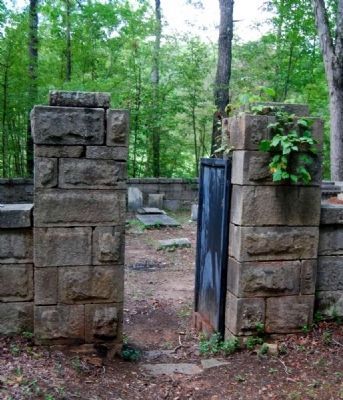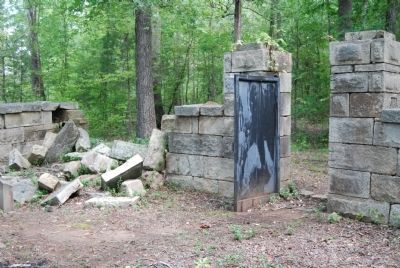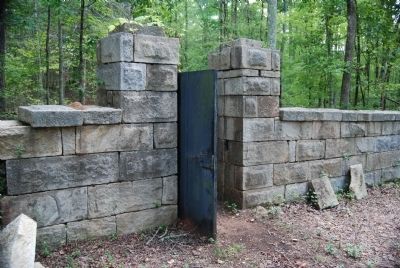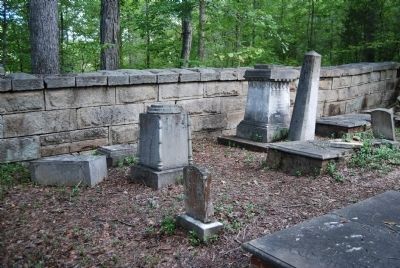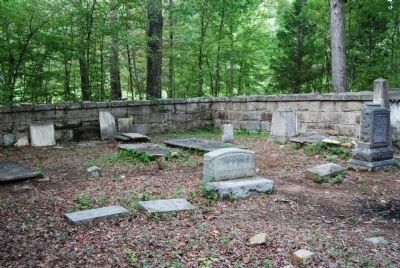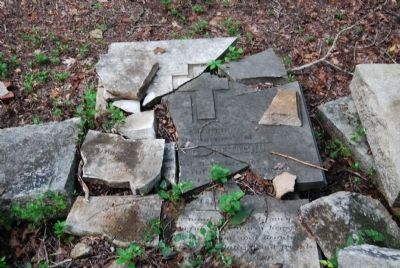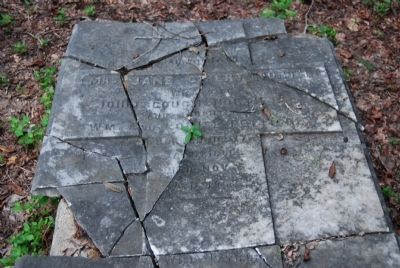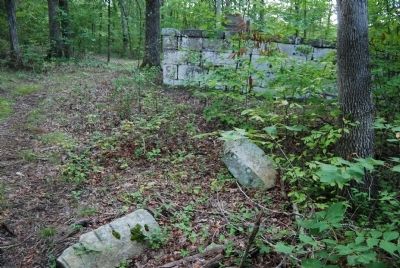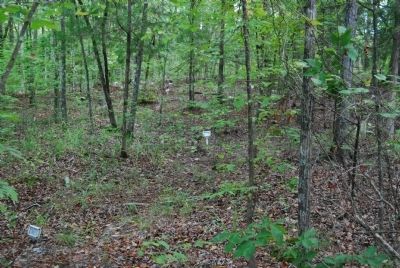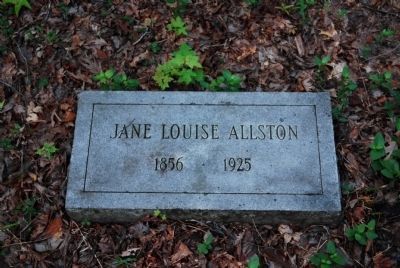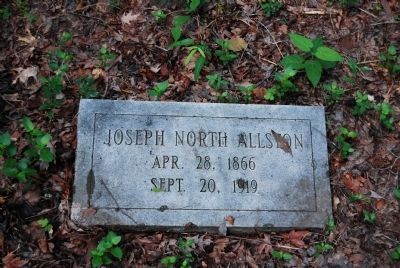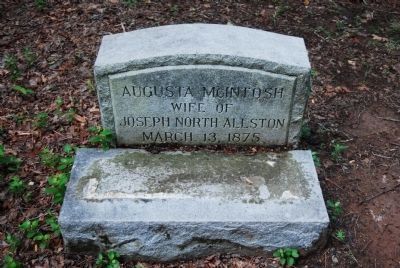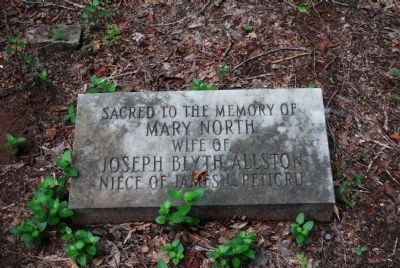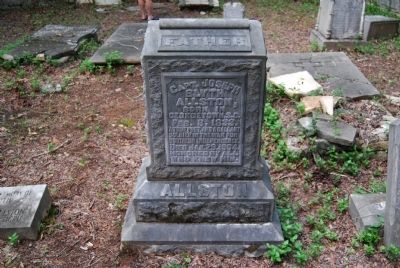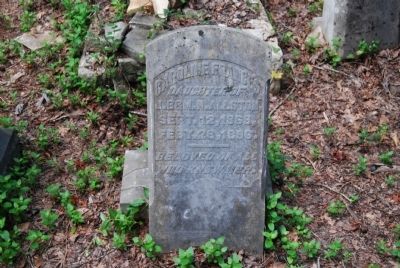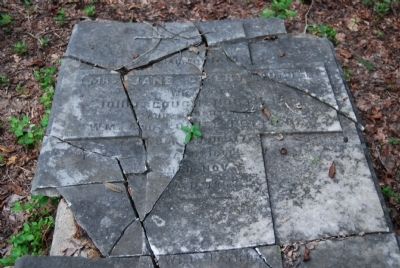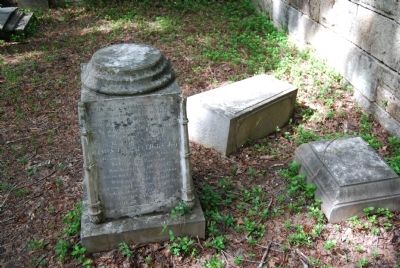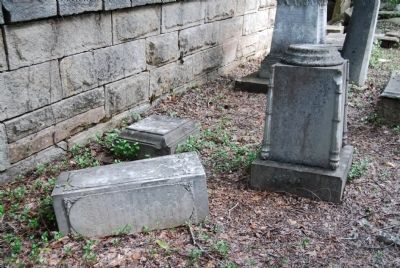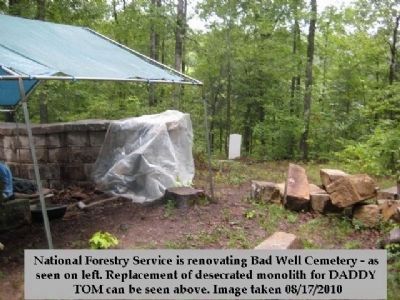Near McCormick in McCormick County, South Carolina — The American South (South Atlantic)
Badwell / Badwell Cemetery
Badwell
Three miles west is the site of "Badwell," home of James Louis Petigru (1789-1863), leader of opposition to secession in South Carolina, outstanding Charleston lawyer, and S.C. Attorney General. He studied at Willington Academy under Moses Waddel and at South Carolina College. The Petigru Law School at the University of South Carolina is named in his honor.
Badwell Cemetery
Located four miles west is Badwell Cemetery. Among the graves are those of Rev. Jean Louis Gibert (1722-1773), leader of the 1764 French Huguenot settlement at New Bordeaux and grandfather of James L. Petigru, his son, John Joseph Gibert, William and Louise Petigru, parents of James L. Petigru, and Louise Gibert Allston, daughter of Governor R.F.W. Allston.
Erected 1973 by McCormick County Historical Commission. (Marker Number 33-6.)
Topics and series. This historical marker is listed in these topic lists: Cemeteries & Burial Sites • Settlements & Settlers • War, US Civil. In addition, it is included in the South Carolina, McCormick County Historical Commission series list. A significant historical year for this entry is 1764.
Location. 33° 55.775′ N, 82° 19.836′ W. Marker is near McCormick, South Carolina, in McCormick County. Marker is at the intersection of Savannah River Scenic Byway (State Highway 28) and Barksdale Ferry Road (County Route S-33-61), on the left when traveling west on Savannah River Scenic Byway. Touch for map. Marker is in this post office area: Mc Cormick SC 29835, United States of America. Touch for directions.
Other nearby markers. At least 10 other markers are within 4 miles of this marker, measured as the crow flies. Dorn’s Mill / Dorn Gold Mine (approx. 2.2 miles away); Dorn Mill (approx. 2.3 miles away); Dorn Mill Complex (approx. 2.3 miles away); McCormick County / MACK (approx. 2.4 miles away); McCormick Passenger Train Steps (approx. 2.4 miles away); McCormick County Veterans Monument (approx. 2˝ miles away); McCormick County Confederate Monument (approx. 2˝ miles away); McCormick Train Station (approx. 2˝ miles away); New Bordeaux Worship Site (approx. 3˝ miles away); Welcome to Baker Creek State Park (approx. 3.6 miles away). Touch for a list and map of all markers in McCormick.
More about this marker. From the marker, proceed west on Barksdale Ferry Road (Road 33-61) and continue for about two miles. Turn right onto Huguenot Parkway and proceed for another two miles. Turn left on Badwell Cemetery Road (a dirt/gravel road). Take the left fork to the cemetery.
Regarding Badwell / Badwell Cemetery. Local legends speak of a troll that lives near the cemetery. He can be seen watching over the hallowed ground.
Also see . . .
1. James Lewis Petigru. James Louis Petigru (May 10, 1789-March 9, 1863) was a lawyer and politician in South Carolina. (Submitted on September 17, 2008, by Brian Scott of Anderson, South Carolina.)
2. James Lewis Petigru, the Willington Academy and Their Enduring Legacies on South Carolina. (PDF) Calhoun Lecture Series, January 24, 2006 (Submitted on September 17, 2008, by Brian Scott of Anderson, South Carolina.)
3. Moses Waddel. Moses Waddel (June 20, 1770 - July 21, 1840) was an American educator and minister in antebellum Georgia and South Carolina. (Submitted on November 24, 2009, by Brian Scott of Anderson, South Carolina.)
4. Ghosthunting -- Badwell Cemetery Daytime Investigation. CSRA Ghostbusters take a daytime look at Badwell Cemetery in McCormick County, SC. (Submitted on November 24, 2009, by Brian Scott of Anderson, South Carolina.)
5. Badwell Plantation – Willington – McCormick County. Location – Buffalo Creek (a branch of Little River), Willington, Abbeville District, McCormick County. (Submitted on November 24, 2009, by Brian Scott of Anderson, South Carolina.)
Additional commentary.
1. Badwell Plantation
Badwell Plantation, located on Highway SC 28 south of the eastern terminus of SC
81, was the home of the Rev. Jean Louis Gibert. He is buried in a small family cemetery near the house site. After his death, the property eventually passed to his grandson, James Louis Petigru, the son of his daughter Louise and William Pettigrew. (Petigru preferred to use the French spelling of his father's family name.) He improved the plantation at every opportunity and planted a handsome White Oak Avenue from the highway to the house. The origin of the name Badwell is doubtful; however, Petigru went to much trouble and expense to drill a dependable water well on his property and this well may have been the source of the name, The house at Badwell was destroyed by fire in the late 1920's. Only the stone spring-house remains.
(Source: http://www.cas.sc.edu/iss/SCNames/index.php?action=showPage&book=3&volume=20&page=36.)
— Submitted December 7, 2009, by Brian Scott of Anderson, South Carolina.
2. James Louis Petigru (1789-1863)
by Richard D. Starnes
Historians have traditionally portrayed prominent antebellum white southerners as monolithic in their support of slavery and states' rights. Such a view minimizes the role of an important minority who criticized slavery, supported the Union and attacked the social and economic foundations of southern life.
no southern dissenter was more important than James Louis Petigru.
Petigru was born near Abbeville, South Carolina, on May 10, 1789, the first of eight children. his father, William Petigru, soon lost his land to gambling and drinking and came to rely on his wife's brother to support his family. James grew up doing farm chores much as did any youth of the period. However, his mother imbued him with a deep intellectual curiosity and schooled him at home until he was fifteen, when he entered a local academy. Two years later, he began his studies at South Carolina College in Columbia. Graduating in 1809, James read law with Beaufort attorney William Robertson and was admitted to the bar in 1812. During this time, he also changed the spelling of his name to "Petigru," a reflection of his poor relationship with his father. Then he embarked on one of the most brilliant and controversial legal careers in the history of southern independence.
Petigru's legal practice was initially lackluster, but he found success after David Hugen, a prominent South Carolina lawyer and politician, took an interest in his career. In rapid succession, Petigru became a state solicitor, a partner in a powerful Charleston firm, and state attorney general. In court, he often made arguments that were unpopular with other white southerner elite, and on several occasions, he took cases brought by slaves against their masters, arguing for the extension of basic human rights for slaves. As attorney general, he argued that South Carolina's Negro Seaman Law, which prohibited black sailors from coming ashore in the state, was unconstitutional. These actions do not mean that Petigru was a racial egalitarian. Rather, he believed that slavery was an impediment to the South, one that prevented social reform and economic development. to end the institution, he favored manumission, a controversial practice that involved owners freeing their slaves by bequest.
Petigru's opposition to slavery was not the only view that placed him in conflict with prominent leaders on his state and region. He also opposed nullification, a stand that placed him at odds with powerful politicians such as John C. Calhoun. Petigru considered nullification an unconstitutional act. In Petigru's view, federal law superseded state laws, and if a state took issue with a federal act, it should seek relief through the judicial and legislative channels established by the U.S. Constitution. Armed confrontation, according to Petigru, was not a viable solution. For many of the same reasons, he later opposed secession, becoming a vocal unionist until his death in 1863. His views on slavery, nullification, and secession set James Louis Petigru at odds with the prevailing opinions of the day and made him one of the great southern dissenters of the antebellum period. (Source: Slavery in the United States: A Social, Political, and Historical Encyclopedia, Volume 2 by Junius P. Rodriguez (2007), pgs 415-416.)
— Submitted November 24, 2009, by Brian Scott of Anderson, South Carolina.
3. Petigru and Badwell
When James [Petigru] was eleven years old, his father went bankrupt. William lost money on horse races at nearby Vienna and Petersburg, on farm prices and land speculation. he dreamed too much and did too little. William sank into brooding despair, only to have his family rescued by his wife's brother -- John Joseph Gibert [son of Jean Louis Gibert].
Joseph lived on a beautiful nearby farm named "Badwell." It was a breathtaking sweep pf land, with rolling hills, rich fields, bordered by Little River and Buffalo Creek. There was room and work for the Petigru family at Badwell.
From the moment his wagon wheel hit the first inch of Badwell land, young James fell in love with the farm. The wind in the trees, the flowers, the birds, spoke to the boy in a sunburst of beauty. For the next sixty-three years, Badwell spoke to Petigru's heart. This land, perhaps so common to another eye, became his spiritual home.
Petigru often said that no air smelled so sweet
as the air that rustled in Badwell trees. No water tasted so cold and pure as that in the Badwell well. no flowers (not even in Charleston) bloomed in such a riotous rainbow and no October colors shown so russet, red and gold.
At age eleven, with his first glimpse of the farm, he determined to own it someday. In his mind's eye, he saw a mile-long avenue of trees, stretching from the entrance gate to the house on the crest of a hill. Indeed, as a man, Petigru lavished thousands of dollars on new trees, a deep well, Scottish gardeners and expensive landscaping...
It was Badwell, his upstate boyhood home, that throughout his life spoke to Petigru's heart. He came to Badwell for his month-long August vacations, and at every other opportunity. There he could be at ease. He enjoyed the company of his favorite sister, Jane, and lavished the "gentleman farmer" lifestyle. He did physical work on the farm that was therapy for his demanding legal profession. on Badwell he could escape the torment of constantly impending one-after-another political crisis.
With the first money Petigru earned he built a new house for the family at Badwell. He strived to improve the farm and at every opportunity added to its acreage. Bordering farms purchased included Bayfield, Goodwell, Tidlam, Ryeworth, and China Grove, and tracts of land from Jones and Squire Collier. He actively participated in the decisions of operating the plantation. He implemented a program of soil and water conservation and soil fertilization, and met the challenges of weather related problems.
Petigru provided an Episcopal Chapel-of-Ease for holding worship services at Badwell.
For years he worked on a mile-long avenue thirty feet wide from the home to the main road. On either side he planted oak trees, spaced fifty feet apart. The oak avenue was planted predominately to white oaks, but also included laurel oaks, Spanish oaks, red oaks, cork oaks, and willow oaks. Some trees were sent to him from other states. Each tree he named for a friend, thereby making the oak avenue a living memorial.
A local stone quarry was established to provide material for the construction of a stone spring house and a stone enclosure for the family cemetery. Petigru established walks and gardens around the home. Live oaks brought from lowstate and blooming flowers and shrubs can still be identified at the site of the Badwell home.
Petigru was a serious history scholar. He was a founding member and first president of the South Carolina Historical Society in 1855 and an honorary member of the Massachusetts Historical Society. He was instrumental in the collection and publication of many South Carolina colonial documents. (Source: The Making of McCormick County by Bobby F. Edmunds (1999), pgs 221, 229-230.)
— Submitted December 7, 2009, by Brian Scott of Anderson, South Carolina.
4. Moses Waddel and the Willington Academy in South Carolina
One morning in the late autumn of the year 1794, a Presbyterian preacher left the Georgia side of the Savannah River and crossed over to South Carolina. He was of low stature and had a boyish face, for he was only twenty-four years of age. He rode to a schoolhouse that stood in the Calhoun Settlement, on Long Cane Creek, in Abbeville District, and found assembled there a company of Scotch-Irish people. When he arose to speak, the congregation was surprised to hear a deep-toned, musical voice. The preacher's calm, gray eyes looked straight into their eyes and his earnest, rapid talking caught their attention. When the sermon was ended, Patrick Calhoun, patriarch of the community and elder in the neighboring church, led the minister to his home. While they were seated, that evening, around the wide, old-fashioned fire-place in the Calhoun home, the door was opened and a youthful face looked in, but was at once withdrawn. The face belonged to John Caldwell Calhoun, Patrick Calhoun's son, who afterwards became South Carolina's great statesman. A year later, the young minister, whose name was Moses Waddel,
married Catharine Calhoun, sister of John C. Calhoun, and took her to his home beyond the Savannah. There, in Georgia, Waddel was preaching the gospel and teaching Latin and Greek to a group of schoolboys.
Moses Waddel was born (1770) in Iredell County, North Carolina. His parents were Scots from North Ireland. Soon after Moses completed his eighth year he went to James Hall's school and began to study Latin. After six years of work, he finished the courses of study in Greek, Latin and mathematics, as far as these subjects were taught in the school. Then he took charge of various schools in North Carolina and Georgia until the year 1789, when he gave his heart to Christ. After a long struggle within his own breast, young Waddel determined to become a preacher. In the autumn of 1790, therefore, he mounted his horse and made the long journey from Georgia to Virginia. In the month of September in that year he began a course of study at Hampden Sidney College. A little more than a year later he left the college, and in May, 1772, was licensed by Hanover Presbytery to preach the gospel. The year 1794 found him established as pastor of Carmel Church, south of the Savannah. At the same time he organized a school in Columbia County, Georgia. Near the close of that year he crossed the Savannah, as we have seen, and there met Catharine Calhoun, who became his wife and his helper
in the Georgia school. In 1801 Waddel moved his home to Abbeville District, South Carolina, and there opened his school in the village of Vienna. A little later, however, he selected a site upon a ridge near the Calhoun Settlement. There, among oak and hickory trees, he erected a log house and called it Willington Academy. Log cabins for the students were put up near the main building. For a long period of time, as many as one hundred and eighty students came each year to receive instruction from this wonderful teacher, Moses Waddel.
The food furnished to the students in Waddel's log college was plain, for it was usually nothing more than cornbread and bacon. A blast from a ram's horn called them all together for morning and evening prayers. When the weather was mild the students sat or lay beneath the trees to prepare their lessons. The sound of the horn told the class in Homer when to assemble, and all of the members of it rushed at once to the recitation hall in the main building. Then the horn called up, in regular order, the Cicero, the Horace and the Virgil classes, as well as those engaged in the study of mathematics and English.
Waddel had a clear mind and a strong will. He gave his pupils an admirable training in all of their studies. Moreover, he held them under his own absolute control through strict discipline. The master loved each pupil. He governed them with love and with impartial justice.
A large company of ministers received their entire training in Waddel's school. Of these we may name Richard B. Cater, John H. Gray, David Humphreys, James Gamble, James C. Patterson and Thomas D. Baird. Some famous scholars and statesmen also were educated in this log college, among whom were William H. Crawford, Howell Cobb and A. B. Longstreet, of Georgia, and John C. Calhoun, Hugh S. Legare, James L. Petigru, George McDuffie, and many others, of South Carolina.
The Willington school building was also a church. Waddel preached every Sunday to his students and to the people of the community. In 1809 these worshippers were regularly organized as a Presbyterian Church. A revival of religion took place there and many of the students became Christians.
During a period of about fifteen years Moses Waddel kept up at Willington the best school in all that part of our country. In 1819 he went to Athens, Georgia, to take charge of the University of Georgia as President. He was then the most famous teacher in the far South, and he at once placed this school upon a high plane of literary excellence. He preached the gospel every Sunday to the body of students assembled in the chapel. He conducted the university as a Christian school throughout his presidency of ten years. At the close of the year 1829 he gave up the heavy
work at the university and went back to Willington. The academy was opened there again under the control of Waddel's son. The old preacher himself spent nearly all of his closing days in giving to the people of that region the gospel of peace. He died in 1840. (Source: Southern Presbyterian Leaders by Henry Alexander White (1911), pgs 199-202.)
— Submitted December 7, 2009, by Brian Scott of Anderson, South Carolina.
5. Reverend Jean Louis Gibert
The maternal grandfather of James Louis Petigru was the Reverend Jean Louis Gibert, pastor at New Bordeaux, the third and last of the French Protestant settlements in South Carolina.
Situated in the foothills of the Cevennes Mountains, fifteen kilometers from the town of d'Alais, in the Province of Languedoc, is the village of Lunes. Here the Gibert family had owned and occupied a small but comfortable house for two hundred and sixty years. They belonged to that strong race of mountaineers who after the Revocation of Nantes were in rebellion against the government of the great King.
Pierre Gibert and his wife Louise Guy had three sons. Pierre the eldest, whose son Pierre was the progenitor of those of the name now living in South Carolina; Jean Louis Gibert born 29th of June, 1722, and Etienne born 2d September, 1736; the last two being known as the "Pastors of the Desert."
Jean Louis was imbued with piety from an early age. In 1746 he entered the Seminary at Lausanne, and after three years' study he was ordained and assigned to the parish of San Martin du Bouboux. He had black hair and gray eyes, classical features and an attractive and determined expression; he was of medium height, well built, strong and active. He was naturally a man of action—a leader of men—and had he not been endowed with the spirit of an evangelist he probably would have been a soldier.
In 1750 he plunged into the work of his pastorate with irresistible courage and zeal, and his duties were continually extended. Tradition tells how he would sometimes appear disguised as a countryman or shepherd, assemble his flock at night in some secluded spot (in French "the Desert") and preach, baptise and administer the sacrament. These assemblies often numbered four to five thousand people. They were frequently dispersed by the soldiers, but this seemed merely to increase his resolve and a few days afterward he would hold another meeting.
In 1755 Jean Louis Gibert with his brother Etienne, who for two years had accompanied him as secretary and a companion, escaped a trap set for them at Pons. Of two other companions one was killed and one captured by the soldiers. In the saddles of these men were Gibert's records and papers, and in consequence, by proclamation, he and his brother were condemned and a price put upon their heads dead or alive. Jean Louis was sentenced to make an act of abjuration, to be hanged, gibbeted and his body thrown into the offal ditch. Etienne was sentenced to be branded on the right shoulder with the letters GAL and sent to the galleys for life. He escaped to Lausanne, where for three years he pursued his studies at the seminary.
Jean Louis continued his work, and with the presence of mind and nerve of a trained scout managed to escape the traps and stratagems to capture him.
When dealing with his flock he was a strict disciplinarian, insisting on temperance and that on Sundays they should abstain from work and amusements and devote themselves to prayers and meditation. He insisted that children should be baptised regardless of the fear of persecution. To a man fearing to have his child baptised by the Pastor the latter told him that he "would be damned by all the devils and hell would be his portion." The man, however, had the child baptised by the priest. When Gibert was informed of the fact the man was immediately excommunicated. The Bishop suggested a modification of the treatment of his parishioners, but he, understanding his people, continued with firmness that brought forth fruit.
In 1755, when there was a relative calm in the persecution, believing that large assemblies in the woods were exposed to the inclemency of the weather and easy detection by the soldiers, the Pastor decided that they should gather in smaller groups, and he had constructed as churches, small unpretentious buildings which if destroyed could easily be replaced. Each was provided with an altar and benches for about two hundred people. The services were very simple. The garb of the preacher was a square black cap, a long straight coat and a blue silk collar.
Persecution was renewed. The churches were used as barracks for the soldiers, were either torn down or burned.
In 1760 Gibert was elected president or Moderator of the Provincial Synod of the churches of Saintonge, Angumois, Perigord and Bordelais, and in spite of persecution the converts increased till they numbered about sixty thousand.
After ten years of unequal struggle he decided to obtain from the government of England authority to conduct a colony to America, and provided with suitable testimonials he arrived in England in April, 1761. He wrote to Stecker, Archbishop of Canterbury, and explained that the object of his mission was to carry a certain number of his people to America for the purpose "of cultivating the vine and raising silk," asking also that the English King should intervene with King Louis XV so that these
Protestants with their wives and children might be allowed to leave France. The Archbishop submitted the letter to Pitt and other ministers and it was eventually conveyed to King George III, and met with his approval.
Gibert returned to France and after a delay of two years obtained from the Synod permission to withdraw from his duties and leave the country. In the month of March, 1763, he arrived in London and announced the coming of the emigrants. Though they had been promised a welcome no arrangements had been made for their reception. Archbishop Stecker again came to his assistance and through his influence King George contributed a thousand pounds for the benefit of the emigrants. To avoid observation they came in small groups and were assembled at Plymouth on the 25th of August.
Unfortunately there was a long delay; consequently, many renounced the projected expedition to America and remained in England. However, through the efforts of Gibert and his colleague, Pierre Boutiton, on the 25th December, 1763, the last emigration of Huguenots to America began to embark at Plymouth on the ship Friendship Captain George Perkins, bound for Charleston, S.C.
While waiting for a fair wind the emigrants found the food bad and some violent language was exchanged between them and the captain; for this, according to the pious chronicler, they incurred the wrath of God and were severely punished. On the 2d of January, 1764, they attempted to raise the anchor but failed, and not until the llth did they set sail. On entering the channel they encountered a violent storm. With difficulty they were saved from shipwreck, and wet, cold and dejected they reached Torbay, twelve miles farther from Charleston than they were when they started. They returned to Plymouth and on the 22d of February, with a favorable wind, they again set sail for America.
After a monotonous voyage of forty-seven days they arrived in Charleston on the 15th of April, 1764. They were sheltered in barracks and food provided for them by the descendants of their bourgeois compatriots, many of whom were from the same province in France and had come to America immediately after the Revocation edict of 1686.
On the 18th of April, 1764, they received from Governor Thomas Boone and Lieutenant-Governor William Bull a grant of ten square miles of land for which they were to pay yearly a penny an acre, which sum was paid until the Revolution.
They selected a section in Abbeville County, then known as the District of Ninety-six. This was on the banks of Little River, twelve miles above its confluence with the Savannah.
On the 12th of October the colonists started from Charleston, and after much difficulty, on the 14th of November, reached their
destination, about one hundred and fifty miles distant. Immediately on their arrival on the right bank of the Little River they cleared a space for a town which they called New Bordeaux in remembrance of the capital of Guyenne, from which place many of them had come. In the center of the town was erected a large building for a storehouse and town hall. Houses were built, and as a protection against the Indians a fort, called Fort Bonne, the remains of which still exist on the lands of Mr. Albert Gibert. To each adult was assigned a half-acre lot within the town for the immediate cultivation of beans and corn. Outside the town limits four acres of land for the cultivation of the vine and silk was granted, and in addition a bonus of one hundred acres.
By June, 1765, they had finished planting corn and beans on the land assigned them.
At first they suffered the usual hardships of pioneers, but after the second year they produced all that was necessary for the support of their families.
The vine and silk were cultivated, but the productive crops were tobacco, corn, hemp and indigo; and after seven years of hard work the colony was in a most prosperous condition.
The Pastor devoted himself to the spiritual and temporal progress of the country. He taught the school and conducted the church under the Presbyterian form, and the greatest care was given
to the registers of marriages and baptisms.
Before sailing for America the Pastor had married the sister of his colleague, Pierre Boutiton. According to family tradition her given name was Isabeau and Mr. Petigru uses this name in the epitaph of her son, Joseph Gibert.
She may be entitled to both names. But little is known about her, but we can infer that she was a lady of practical tastes from the fact that she brought with her from France a wafer iron marked with the initials "I. B." This wafer iron is still preserved, and occasionally used at Badwell.
The Pastor located his home one mile east of New Bordeaux, selecting the end of a ridge overlooking the valley of Buffalo Creek. He built a comfortable house in which were stored a classical library and various papers relating to his work in France, and also the records of the colony. Unfortunately, all were lost when the house was burned during the war of Independence. After he had succeeded in bringing the colony to a prosperous condition he was, at the height of his usefulness, suddenly cut off by a stupid accident. His cook, John Le Roy, served him at dinner with what he supposed to be mushrooms; he was taken violently ill and died a few days afterwards, in August, 1773, at the age of fifty-one. It is pathetic that a man who had escaped the traps and stratagems of the soldiers of Louis XV, and the
dangers of shipwreck, should have his career ended by the veratria poison of an insignificant toad stool. In the family cemetery, contiguous to his house, his grave is marked by a square marble monument with inscriptions on the sides,— one in Latin, one in French and one in English, by Mr. H. S. Legare; on the fourth side the record of his birth, the date of which differs from that recorded by Crotet.
The sudden death of the Pastor was mourned as a public calamity and his parishioners wept for him as for a father. He was succeeded by his nephew, Pierre Gibert, the son of his elder brother before mentioned, and under him the colony continued to prosper until 1777, when it was found that living in the town produced fever and the people began to settle in the adjacent country. About this time the value of cotton began to be recognized and it was cultivated with other crops. Being unable to wait till the culture of silk and the vine could become profitable it was practically abandoned, although continued by a few for a generation longer.
Pierre Gibert had been educated in England by his uncle, Etienne, and was brought to the colony by his uncle, Jean Louis. He taught school and the colonists are indebted to him for their education in English. He was among the first to embrace the cause of Independence. In a company of the colonists, Joseph Bouchillon was captain
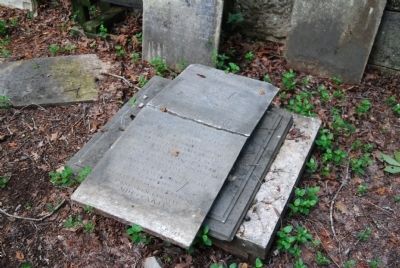
Photographed By Brian Scott, September 13, 2008
22. Rev. John Louis Gibert Tombstone
Memory of
Revd. John Louis Gibert
Born near Alais in Langued
22nd July 1722
Died in August 1773
Jean Louis Gibert,
The Devoted Hugonots not like
other adventurers constrained
by poverty to seek their
fortunes on a distant shore
but in the true spirit of humble
and heroic martyrdom they plunged
into the depths of an untrodden
wilderness to secure that libery
not enjoy in their own
beautiful land.
— Submitted November 24, 2009, by Brian Scott of Anderson, South Carolina.
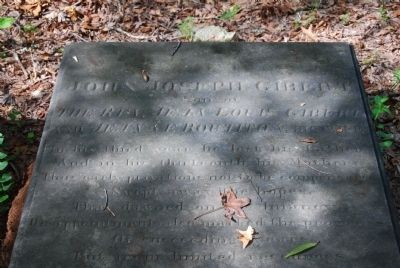
Photographed By Brian Scott, September 13, 2008
23. John Joseph Gibert Tombstone
The Rev. Jean Louis Gibert
and Jeanne Boutiton, his wife.
In his third year he lost his Father.
And in his thirteenth his Mother.
This early privation not to be compensated,
Swept away the hopes,
That dawned on this Infancy.
Disappointment also made the progress
Of Succeeding years
But from limited reassurances
He spared the means to lay
The foundation for the
Education of his Nephew
James Louis Petigru.
Died at Badwell
18th Nov. 1817
Aged 46 years.
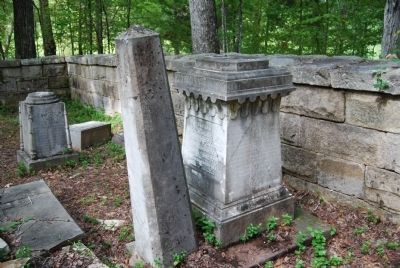
Photographed By Brian Scott, September 13, 2008
27. Comm. Thomas Petigru Tombstone
to the Memory of
Thomas Petigru,
U.S.N. Commander,
Born 1st June 1793,
Died 6th March 1857.
Courage, Feeling and Truth
Marked his Course.
In the Naval Service he enforced
the wholesome laws of discipline
and in private life extended
the open hand of charity.
He loved justice and made the
offender bow to its mandate,
and was therefore persecuted,
vindicated in the face of day.
He was wounded in the dark
and died at his post
demanding reparation.
Clouds obscure the evening of
his day and he bore the hardest
trials without descending from
the elevation of a manly character.
Friendship mourned by his dying
bed nor will the sense of their
loss depart but with life from the
bosom of them with conjugal and
fraternal affection dress this tomb
to his memory.
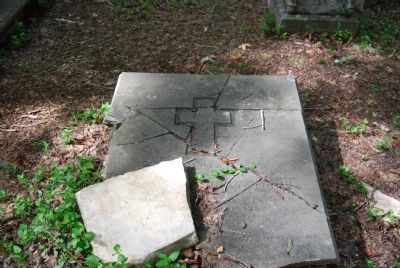
Photographed By Brian Scott, September 13, 2008
28. Mary Ann Petigru Tombstone
Capt. Thomas Petigru,
Born Oct. 18, AD 1793,
Died Jan. 4, AD 1869.
She was marked by great afflictions which
she bore with meekness, courage, and patience.
She sought by the presence of friends to cheer the
gloom of a hearth made desolate by the loss
of her son, daughter, and husband and through
weary years awaited with hope the
summons of her Redeemer.
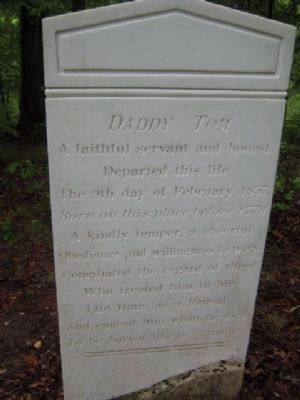
Photographed By Joe Pegasus, August 17, 2010
32. Badwell Cemetery/ Daddy Tom monolith
Inscription:
Daddy Tom
A faithful servant and honest,
departed this life
the 9th day of February 1857.
Born on this place before 1776.
A kindly temper, a cheerful
Obedience and willingness to work
Conciliated the regard of those
Who treated him in his
Life time, as a Friend,
And caused him when he died
To be buried like a Christian.
Credits. This page was last revised on March 4, 2022. It was originally submitted on July 21, 2008, by Brian Scott of Anderson, South Carolina. This page has been viewed 6,631 times since then and 147 times this year. Last updated on September 14, 2008, by Brian Scott of Anderson, South Carolina. Photos: 1. submitted on July 21, 2008, by Brian Scott of Anderson, South Carolina. 2. submitted on December 6, 2009, by Brian Scott of Anderson, South Carolina. 3. submitted on December 7, 2009, by Brian Scott of Anderson, South Carolina. 4. submitted on December 6, 2009, by Brian Scott of Anderson, South Carolina. 5, 6. submitted on November 24, 2009, by Brian Scott of Anderson, South Carolina. 7. submitted on September 13, 2008, by Brian Scott of Anderson, South Carolina. 8, 9. submitted on November 24, 2009, by Brian Scott of Anderson, South Carolina. 10, 11, 12, 13. submitted on September 13, 2008, by Brian Scott of Anderson, South Carolina. 14, 15. submitted on November 24, 2009, by Brian Scott of Anderson, South Carolina. 16, 17. submitted on September 13, 2008, by Brian Scott of Anderson, South Carolina. 18, 19, 20, 21. submitted on November 24, 2009, by Brian Scott of Anderson, South Carolina. 22, 23, 24, 25, 26, 27, 28, 29, 30. submitted on September 13, 2008, by Brian Scott of Anderson, South Carolina. 31, 32. submitted on August 17, 2010, by Joe Pegasus of McCormick, South Carolina. • Craig Swain was the editor who published this page.
Editor’s want-list for this marker. Pictures of the Badwell house. • Can you help?
